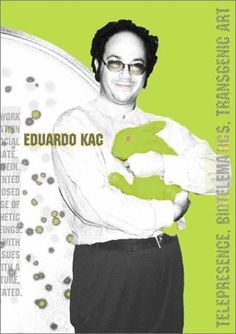As the self-described slayer of dualisms, posthumanism is rumoured to destabilize venerable dichotomies like human/animal & mind/body. Bio-art can perhaps body forth these postulated category meltdowns. The condition of possibility of bio-art’s enmeshing of bodies with technologies is the structural intimacy of art & science. The artist will have to romance his bio-technician, and there is no guarantee of a ‘happily ever after.’
If art has characteristics of the moral imperative, aesthetics & ethics in posthumanism are joined at the hip. Science can prattle about ‘ethically obtained donor cells;’ can art speak of ‘ethically obtained animal matter’ for Eduardo Kac’s GFP Bunny? As the rabbit cannot consent, it did not. Yet it was not harmed. But this is splashing around in very shallow waters.
The body as last frontier of cultural colonization is rendered claylike for bio-art because technology does not argue or negotiate with biology, it dictates. So human intelligent design actualises earlier fantasies of imago Dei, and hubris overlays the quest for alternatives to anthropocentrism. The nonhuman body is therefore ontologized as artistic raw material.
Kac’s fluorescent rabbit reproduces the institutional practices of scientific animal research, ethically not unproblematic. And science always has the last word. Kac wanted to adopt the rabbit Alba after the event, but was refused. Hence Alba remained a lab rat for the rest of her life. The aftermath demonstrates why ‘Capitalocene’ is more appropriate than ‘Anthropocene’ for the broken world to come: the procedure was commercialized for GFP zebrafish, sold as ‘GloFish.’
More sophisticated defenses of GFP Bunny: (i) visualising the non-visual (genetic engineering); (ii) questioning the construction of ‘difference’ via the gene as a social marker. But that is much ado,- with the life & body of Alba as means,- about precious little, while the animal remains human property to be acted upon as artistic whim dictates. Animal bodies in art was not nurtured in the desert; its necessary conditions are domestication and centuries of animal (ab)use.
How then, has the human/animal dichotomy been undermined in GFP Bunny? And around it frolic all the lesser dualisms that exalt homo sapiens into homo mesura. Ecce posthumanist humanism. Will posthumanist posthumanism remain an uninstantiated Platonic form forever and a day?

Leave a Reply
4 Comments on "Art in Animalface"